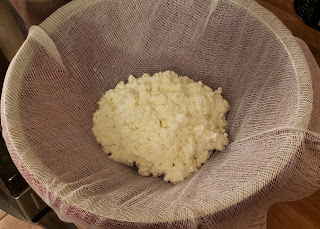Last month, as part of The Great Big Jewish Food Fest, Liz Alpern and Jeffrey Yoskowitz hosted a live session on making various Ashkenazi pantry staples. Alpern and Yoskowitz are the founders of The Gefilteria and authors of The Gefilte Manifesto. Their mission is to keep Ashkenazi food traditions alive for the modern world. Many Ashkenazi food traditions were born out of necessity, lacking resources in the shtetlekh of central Europe. The session included pickles, schmaltz, and farmer's cheese. In the Midwest in the modern day, many of these staples are hard to find in stores, so we've turned to making them ourselves.
I've been making schmaltz for several years now. Every time we buy skin-on chicken thighs or leg quarters, I trim off excess skin around the edges and save it in the freezer. These can easily be defrosted later for rendering. I had not, however, made farmer's cheese. This was a childhood favorite of Ariel's, and the live session inspired us to try it out. Farmer's cheese is a fresh cheese, similar to Indian paneer, but loose instead of pressed into a block. It turns out to be incredibly easy, with only two ingredients: milk and vinegar, plus some cheesecloth. We also saved the whey and have been using it in bread making.
We then put the farmer's cheese to use as a filling for blintzes, essentially rolled up crepes. I've had the frozen ones many times (usually Trader Joe's), but there is really no comparison to making them fresh. Blintzes are usually served with sour cream and some kind of fruit. This turned out to be a perfect application for rhubarb sauce. We followed the recipes given in The Gefilte Manifesto for both the cheese and the blintzes. I will show the process, with pictures, but instead of giving the full recipe, I'll just encourage you to buy the book instead. It's great for both Jewish culinary veterans and amateurs like me.
Farmer's Cheese
Heat a gallon of whole milk to 180 degrees F. Add half cup white vinegar. The milk will immediately start to curdle.
Line a mesh strainer with cheesecloth over a large bowl. Pour out the pot into the strainer. The curds will be captured in the cheesecloth and the whey will run into the bowl. Reserve the whey for another use.
Allow to drain for a while, then tie up the cheesecloth into a bundle. Hang the bundle over a sink or bowl and continue to drain. Season with salt, transfer to a sealed container, and refrigerate.
We transferred the whey back into the gallon jug. To use in bread, replace the water in the dough with whey.
 |
| Whey from one batch of farmer's cheese |
Cheese Blintzes
Start by making the crepes and preparing the filling. This is a good two-person job - Ariel made the crepes while I did the filling. It was a pretty standard crepe recipe, but the trick is to only cook them on one side. The other side gets browned later, after the blintzes are rolled. The recipe says it makes 16 crepes, but we only got 12 out of it.
The filling was a mix of the farmer's cheese with some cream cheese, eggs, sugar, and 4 lemons worth of zest.
To form each blintz, take one crepe, cooked side up, and place filling close to one edge. Fold the edge over the filling, fold in the sides, and roll up. Set aside, seam side down. Flatten each roll a bit.
Once all blintzes are rolled, some can be set aside for later and frozen, if desired. Cook blintzes with butter until browned on both sides. Serve with sour cream and rhubarb sauce.








No comments:
Post a Comment